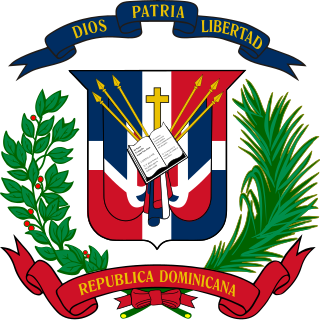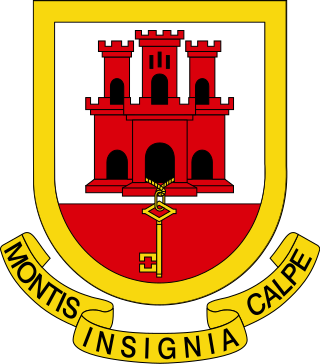Related Research Articles

The coat of arms of South Africa is the main heraldic insignia of South Africa. The present coat of arms was introduced on Freedom Day, 27 April 2000, and was designed by Iaan Bekker. It replaced the earlier national arms, which had been in use since 1910. The motto is written in the extinct ǀXam, member of the Khoisan languages, and translates literally to "diverse people unite". The previous motto, in Latin, was Ex Unitate Vires, translated as "From unity, strength".

A motto is a sentence or phrase expressing a belief or purpose, or the general motivation or intention of an individual, family, social group, or organisation. Mottos are usually found predominantly in written form, and may stem from long traditions of social foundations, or from significant events, such as a civil war or a revolution. One's motto may be in any language, but Latin has been widely used, especially in the Western world.

The coat of arms of Ontario is the armorial emblem representing the Canadian province of Ontario. The arms contain symbols reflecting Ontario's British heritage, along with local symbols. At the upper part of the shield is the red cross of St. George, representing England. The lower portion of the shield features three golden maple leaves on a green background.

The coat of arms of Belgium bears a lion or, known as Leo Belgicus, as its charge. This is in accordance with article 193 of the Belgian Constitution: The Belgian nation takes red, yellow and black as colours, and as state coat of arms the Belgian lion with the motto UNITY MAKES STRENGTH. A royal decree of 17 March 1837 determines the achievement to be used in the greater and the lesser version, respectively.

The current flag of the Falkland Islands was adopted on 25 January 1999 and consists of a defaced Blue Ensign, with the Union Flag in the canton and the Falkland Islands coat-of-arms in the fly.

The national emblem of the Democratic Republic of the Congo has changed several times since 1997. The current one was introduced in 2006 and depicts a leopard head, surrounded by an elephant tusk to the left and a spear to the right. Below are the three words which make up the national motto: Justice, Paix, Travail. It was adopted on 18 February 2006 by President Joseph Kabila.

The official coat of arms of the Republic of Costa Rica was designed in 1848, with modifications in 1906, 1964, and 1998. The latest change was the addition of smoke to distinguish the three volcanoes.

The coat of arms of Toronto is a heraldic symbol used to represent the city Toronto. Designed by Robert Watt, the Chief Herald of Canada at the time, for the City of Toronto after its amalgamation in 1998. The arms were granted by the Canadian Heraldic Authority on 11 January 1999.

The current coat of arms of Zimbabwe was adopted on 21 September 1981, one year and five months after the national flag was adopted. Previously the coat of arms of Zimbabwe was identical to the former coat of arms of Rhodesia.

The coat of arms of the BBC was adopted in March 1927 to represent the purpose and values of the corporation. It is seldom used nowadays except for ceremonial purposes.

The coat of arms of Malta is the national coat of arms of the country of Malta.

The coat of arms of Ottawa was presented to the municipality of Ottawa by Vincent Massey on 20 October 1954.

The coat of arms of Scotland, colloquially called the Lion Rampant, is the coat of arms historically used as arms of dominion by the monarchs of the Kingdom of Scotland, and later used within the coat of arms of Great Britain and the present coat of arms of the United Kingdom. The arms consist of a red lion surrounded by a red double border decorated with fleurs-de-lis, all on a gold background. The blazon, or heraldic description, is: Or a lion rampant Gules armed and langued Azure within a double tressure flory-counter-flory of the second.

The coat of arms of the Dominican Republic features a shield in similarly quartered colors as the flag, supported by a bay laurel branch (left) and a palm frond (right); above the shield, a blue ribbon displays the national motto: Dios, Patria, Libertad. Below the shield, the words República Dominicana appear on a red ribbon. In the center of the shield, flanked by six spears, the front four holding the national flag, is a Bible which is open to John: 8:31–32 with a small golden cross above it. The coat of arms appears in the center of the flag of the Dominican Republic.

The coat of arms of Gibraltar was first granted by a Royal Warrant passed in Toledo on 10 July 1502 by Isabella I of Castile during Gibraltar's Spanish period. The arms consists of an escutcheon and features a three-towered red castle under which hangs a golden key.

The official coat of arms of Grenada is a shield divided into four parts by a golden cross. In the centre of this cross is the Santa Maria, Columbus' flagship. A lion passant guardant on a red field is shown in the upper left and lower right sections of the shield, with a golden crescent moon out of which a lily grows in the upper right and lower left sections. Above the shield there is a golden helmet, topped with a garland of bougainvillea branches. Within the garland are seven red roses, which stand for the seven communities of Grenada. Holding the shield on the dexter side is a nine-banded armadillo which stands before a corn stalk; on the sinister side is a Grenada dove, which stands before a banana plant. The base represents Mount St. Catherine with the Grand Etang Lake at the centre. A ribbon displays the national motto: "Ever conscious of God we aspire, build and advance as one people."

The coat of arms of the Republic of Seychelles shows a shield, in which a giant tortoise is located on green grounds. On the ground there is a coco de mer palm tree. Behind it there is a blue sea with two islands and a sail ship to be seen. The shield is enthroned by a silver helmet, on which a white-tailed tropicbird is located above blue and white waves. The shield is supported by two white sailfish. Beneath the shield the motto of Seychelles is stated: "Finis Coronat Opus".

The flag of Pittsburgh is a triband flag featuring vertical bands of black and gold and Pittsburgh's coat of arms in the center.

The coat of arms of Amsterdam is the official coat of arms symbol of the city of Amsterdam. It consists of a red shield and a black pale with three silver Saint Andrew's Crosses, the Imperial Crown of Austria, two golden lions, and the motto of Amsterdam. Several heraldic elements have their basis in the history of Amsterdam. The crosses and the crown can be found as decorations on different locations in the city.

The coat of arms of Mississippi is an official symbol of the State of Mississippi.
References
- 1 2 3 4 "Trademarks". City of Yellowknife. Retrieved 25 March 2017.